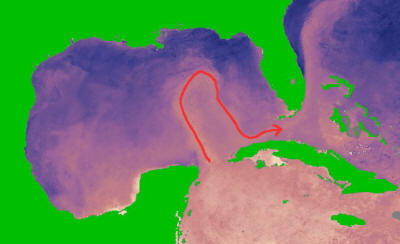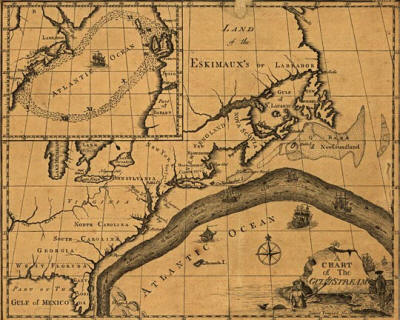An Open System in Trouble
by Marshall Masters
August 01, 2010
from
YOWUSA Website
The Loop Current is a clockwise flow
that extends northward into the Gulf of Mexico and joins the
Yucatan Current and the Florida Current to the Gulf Stream.

The Loop Current
Although at first glance the Loop
Current appears confined within the Gulf, scientists define it
as an “element of an extremely complex, open system”: as all
other “elements” of the so-called “Earth System”, are not
separable from the others.
These various “elements” of the Earth System (i.e., atmosphere,
landmasses and so forth) are so strongly correlated to one
another that at some point, they become indivisible.
Why is this important to all life on the planet?
The Gulf Stream
is a strong interlinked component of the Earth's global network
of ocean conveyor currents, which drive the planet's weather
systems.

For this reason, Zangari's concern
is that should the Loop Current fail to restart, dire global
consequences may ensue as a result of extreme weather changes
and many other critical phenomena.
The repercussions of which
could trigger widespread droughts, floods, crop failures and
subsequent global food shortages.
While pundits are certain to trivialize the ramifications of
this event, “the real worry” says Zangari,
“is that that there is no
historical precedent for the sudden replacement of a natural
system, with a dysfunctional man-made system. That is, except for the atomic
bomb blasts and contamination as a result of nuclear waste
and nuclear plant accidents, such as the April 1986,
Chernobyl disaster."

April 1986,
Chernobyl disaster
In what is now widely regarded by
many as “Oil's Chernobyl,” Americans, and particularly Gulf
Coast residents are disheartened by a steady stream of
bureaucratically bungled responses, which are now proving to be
just as a deadly as the initial event itself.
Perhaps even more so, as this toxic brew of incompetence, greed,
corruption, oil, Corexit dispersant and other chemicals has
unleashed a man-made disaster in the Gulf, with frightful
possibilities for the future.
The
Corexit Curse

1989 Exxon Valdez
oil spill
The use of
Corexit as a dispersant
was first brought to the public's attention during the 1989
Exxon Valdez oil spill.
A powerful solvent used as a dispersant for oil slicks, public
knowledge about the dispersant and its long-term effects is
hampered by the proprietary protections of its manufacturer,
Nalco Holding Company, which is associated with British
Petroleum (BP) and Exxon.
What is known, is that this petroleum-based formula is regarded
as being at least four times more toxic to life, than the oil is
disperses by many environmentalists.

Spraying the Gulf
Officially, just over one million
gallons of Corexit has been spayed in the Gulf of Mexico, but
reliable sources tell Yowua.com that the actual amount could
easily be twice that much.
Either way, current satellite data of the Gulf feeds tell
Zangari that the Loop Current in the Gulf of Mexico has clearly
stalled due to environmental impacts from a man-made
introduction of oil, which were then compounded by other agents
(Corexit and so on).
Worse yet, these real-time satellite data feeds offers clear
evidence to Zangari that a new artificial system has been
generated in of the Gulf in a remarkably short period of time.
It is this new and unnatural system which has changed the
viscosity, temperature and salinity of the Gulf's seawater,
thereby causing the Loop Current to stall. A system that has
existed for millions of years.
Consequently, there is no possible way for scientists to predict
its future evolution, though corporate spinmeisters and media
pundits will no doubt be sure to offer a bevy of right-sounding
predictions.
Their goal as it has been throughout this ordeal,
will be to deflect attention by trivializing the severity of the
event with simplistic and misleading explanations.

However, researchers like Dr.
Gianluigi Zangari, offer insights that transcend the politics of
oil.
As a theoretical physicist, he currently holds a position as an
associate member of the Research Division of the National
Institute of Nuclear Physics at Frascati National Laboratories (LNF)
of the National Institute of Nuclear Physics (INFN) in Italy. A
prestigious research facility focused on high-energy physics.
However, what makes Dr. Gianluigi Zangari's findings so vital to
the common man, is that for over a decade, he has conducted his
continuous global analysis climate research, using publicly
available data.
Unlike the jealously guarded
formulas for Corexit, anyone can vet his research without having
to run through a gauntlet of corporate lawyers.
Tracking
Zangari's Data
Zangari's assessment is based on daily monitoring of real-time
data oceanographic satellite public data feeds called “Real-Time
Mesoscale Altimetry” from the Jason, Topex/Poseidon, Geosat,
Follow-On, ERS-2 and Envisat satellites.

Oceanographic
Satellites
These satellite feeds are are
captured and made publicly available by NASA, NOAA and by the
Colorado Center for Astrodynamics Research (CCAR) at the
University of Colorado at Boulder.
These CCAR data maps offer researchers like Zangari a continuous
stream of markers for sea and ocean dynamics:
-
surface height
-
velocity
-
temperature
A fourth marker that Zangari has found to
be especially helpful, are chlorophyll infrared emission maps.
This is because they show him
real-time changes in the shape of the Gulf Stream.

Sea Surface
Height

Sea Surface Velocity
In addition to changes in ocean
velocity, Zangari is reporting an equally troubling analysis
with sea surface temperatures.
The data published by Rutgers
University is from National Oceanic and Atmospheric
Administration (NOAA) data maps. Dr. Zangari re-elaborates and
checks these data maps using his own calculus system called SHT
(patented in 1999.)

Sea Surface
Temperatures
Acknowledgments:
Frascati National Laboratories,
NOAA and Rutgers
University (http://marine.rutgers.edu).
Analysis by Dr.
Gianluigi Zangari (Frascati Labs)
July 29, 2010.
Taken altogether, these four
oceanographic markers began taking a turn for the worse, shortly
after the
Deepwater Horizon well explosion on April 20, 2010.
This rapid turn of events raised
Zangari's concerns about the Gulf's Loop Current, and then on
July 28, 2010 the worst case imaginable happened.
“The Loop Current simply
stalled,” Zangari noted sadly “and we have no idea if it can
reorganize itself, because now we're dealing with troubling
unknowns.”
Velocity and
Temperature Worries
At present, Admiral Thad Allen is trying to assure Americans
that the worst of the disaster has passed and that the oil
slicks have disappeared due to natural processes. However the
markers from oceanographic satellite feeds Dr. Zangari is
studying tell him an entirely different story.
The millions of gallons of
Corexit sprayed in the Gulf have
given BP and the US government a convenient way to mitigate
public concerns by removing the threat from sight. The logic
being that since the oil is disappearing, so is the crisis.
However, taking oil from the surface and spreading through the
water column is not a PR matter. Instead, it has become a
convenient way to cover up one massive mistake, with a
tragically larger one.
To help understand why, let's assume that what is really
happening in the Gulf is not much different from what happens
when you shake a bottle of oil and vinegar salad dressing. Leave
the bottle on the shelf for a while and the oil and vinegar will
naturally separate, each with it's own unique viscosity.
However, when the bottle is shaken the two are mixed. This
creates a new, and overall thicker viscosity, hence the dressing
pours more slowly. In very simple terms, this is what happened
in the Gulf of Mexico, which begs another question.
Was the Gulf of Mexico intentionally
written off early on, so as to protect the Gulf Stream and
America's
NATO partners?
Will This
Stall Spread Into the Atlantic?

The importance of the Gulf Stream
was brought to the forefront in the blockbuster film The Day
After Tomorrow (2004) where the Gulf Stream stalled, causing
temperatures in New York City to plummet from sweltering to
freezing in a matter of hours.
Based on real science, the film showed movie audience how the
the Gulf Stream transports warm water from the equatorial
regions of the Earth, along American's Eastern seaboard and then
across the Atlantic to Northern Europe.
Now, current temperature measurements for the Gulf Stream on the
Atlantic Front (from 76 to 47 meridian) now appears to be about
10 degrees Celsius cooler than it was this time last year.
Consequently, a direct causality nexus has now been established,
between the stall of the Gulf Loop Current and this new
temperature drop in the Gulf Stream on the Atlantic Front.
For this reason, the focus of Zangari's research is presently
centered on finding signs of a return to the former natural
equilibrium of the Gulf. Again, he stresses making predictions
(pessimistic or optimistic alike) because “these phenomena are
unpredictable because they are ruled by strong non-linearities.”
Nonetheless, we must must ponder the question: What does this
new nexus portend for our future?
To that, Zangari says,
“we can affirm that this system
(the Gulf Stream) is changing in an unpredictable way, which
may produce serious consequences on planetary scale.”
Yowusa.com will report new
developments in Dr. Zangari's research as they become available.















